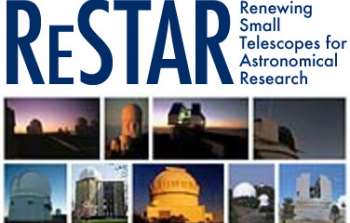sci10008 — Announcement
ReSTAR Announcement of Opportunity in Preparation for Phase 2
July 31, 2010
As described in earlier issues of Currents, NOAO’s committee on Renewing Small Telescopes for Astronomical Research (ReSTAR) provided a compelling case for modernizing the capabilities on telescopes smaller than 6.5-m in aperture in the US System and increased access to these facilities. The ReSTAR committee activity is one of the pathways by which NOAO has been working to ensure that community access to facilities remains scientifically balanced over all apertures, a guiding principle articulated in the 2006 Senior Review Committee of the NSF Division of Astronomical Sciences. To address the ReSTAR committee recommendations, NOAO proposed a ten-year implementation plan.
We are now at the midpoint of Phase 1 of the ReSTAR implementation plan, a phase that extends for three years. As a result of the work carried out to date, it is apparent that by the end of Phase 1, the availability of high-performance instrumentation on 4-m class telescopes will have vastly improved. The next generation of wide-field imagers, including NEWFIRM, DECam, and ODI, will be in place or imminent. The workhorse spectrographs on the NOAO 4-m telescopes, in both the North and South, will have been replaced with modern instruments (versions of the OSMOS spectrograph). The SOAR telescope, with an instrument complement that includes ground-layer AO, medium- and high-dispersion spectroscopy, and near-IR imaging, will be in full operation. Partnerships, such as the current agreement with Caltech that provides nights on the Hale 200-inch telescope at Palomar, will augment the capabilities and observing time that are available through an open-access process.
It is now time to begin planning for Phase 2 of the ReSTAR implementation plan, as there are still many capabilities that do not exist or are in insufficient supply in the smaller aperture component of the US System. Furthermore, the evolution of other parts of the System, in particular the coming stream of discoveries by time-domain surveys, will accelerate the need for follow-up observations on facilities below 6.5-m in aperture.
To take steps in that direction, NOAO recently reconvened the ReSTAR committee to update their perspective on the development of the smaller aperture component of the US System, and to review the priorities and process for Phase 2. Their report (Update 2010) is available from the ReSTAR homepage.
One obvious deficiency of the Phase 1 process was that, in the interest of rapid progress, NOAO carried out a more limited search for community partners than would have been ideal. To address this issue, we are initiating an early start on the planning process for Phase 2, in order to hold an open solicitation for partners to collaborate on the next set of ReSTAR activities.
Through the open solicitation process, NOAO aims to identify partners to carry out activities that will strengthen the smaller aperture component of the US System. Strengthening the System could include developing new instrumental capabilities, providing new open-access opportunities on observing facilities, renewing facility infrastructure, among other possibilities. Guidance on the priorities of the program will come primarily from ReSTAR committee reports.
The selection process will include the release of a draft solicitation document, an open community meeting to discuss the draft solicitation document and possible partnership opportunities, the release of a final solicitation document, the submission of written proposals, and a review by a non-advocate peer review committee. Successful proposers will collaborate with NOAO on a funding proposal to the NSF. The anticipated level of funding to be proposed for is $10-12 million over the three-year period, FY2012-2014.
Our preliminary schedule for these activities is as follows:
- The draft solicitation document is available now from the ReSTAR homepage. The document includes a more detailed description of the solicitation, including eligibility, review criteria, etc.
- The informational meeting to discuss the solicitation will be held Monday, 15 November 2010, at a site to be determined in Tucson, Arizona. Although the primary audience for this meeting is potential proposers, the meeting will be open to any member of the US astronomical community who is interested in participating in the discussion. Information on how to register for the meeting is given in the draft solicitation.
- The final version of the solicitation will be released on the ReSTAR website by 1 December 2010.
- Proposals will be due by 1 February 2011. A non-advocate peer review panel will meet later that month to review and rank the proposals.
- Based on the recommendations of the review panel, NOAO will negotiate memoranda of understanding with the selected partners. These will guide the development of a proposal to be submitted to the NSF early in FY 2012.
We encourage active participation in this process. Please contact us at currents@noao.edu with questions and comments.
Contacts
NOAO
currents@noao.edu
About the Announcement
| Id: |
ID
sci10008
|


